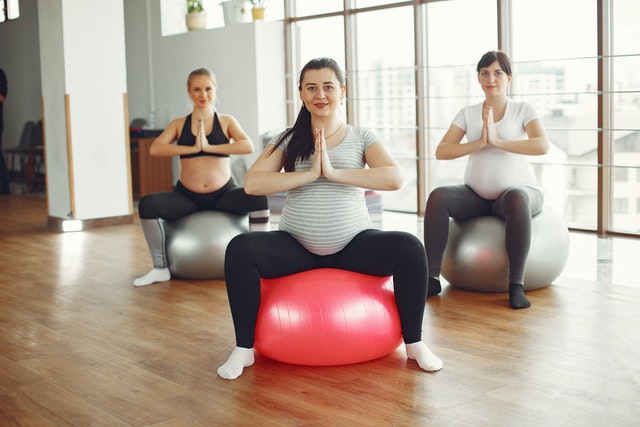If you’re pregnant (or planning a pregnancy) there are two vital issues to think about in terms of your lifestyle and routine: pregnancy nutrition and pregnancy exercise. Many people assume being pregnant limits what you can safely do with regard to exercise. If you make the right tweaks to your fitness plan, however, a comprehensive exercise program including strength and flexibility activities can make your pregnancy healthier and easier, and have the added benefit of supporting your baby’s development. Combined with appropriate pregnancy nutrition, a safe and effective exercise plan will set you and your kiddo on the path to health and success!
Benefits of Pregnancy Exercises
There are plenty of upsides to establishing (or continuing) a fitness routine when you’re pregnant. Not only can it help to reduce the impact or chances of developing gestational diabetes, pregnancy-related high blood pressure, and fetal macrosomia (which is when your baby is born with a high birth weight), it can also ease some of the, shall we say, less than awesome side effects of pregnancy.
Here are a few benefits of pregnancy exercises.
Mood improvement
As we’ve mentioned in earlier posts, physical activity can give your mental health a boost. When you’re pregnant, this can decrease the chances of postpartum depression and keep your positive attitude strong.
Energy boost
Pregnancy exercises can help alleviate the fatigue that some expectant mothers experience while their baby is growing and developing.
Better sleep
One of the things that can make pregnancy especially challenging is not getting enough high-quality sleep (and, goodness knows high-quality sleep is going to be tough enough once the baby is born!). Appropriate exercise during pregnancy can help you sleep soundly.
Stamina, strength, and flexibility improvements
If you do regular exercise during gestation, you can make giving birth easier by increasing your strength, flexibility, and stamina.
Weight gain prevention
Avoiding excess “baby weight” is an added benefit of pregnancy exercise. This doesn’t mean you’ll avoid gaining weight altogether, but it can reduce the impact of pregnancy-related weight gain and make it easier to lose the weight once you’ve given birth.
Back pain reduction or prevention. Being pregnant is no walk in the park, and many moms-to-be experience back pain. Exercise can help prevent or reduce the incidence of pregnancy-related back pain.
Pregnancy Flexibility Training – Dos and Don’ts
Some of the more popular forms of exercise to do during pregnancy are prenatal yoga, Pilates, or other flexibility and resistance training. Combined with good pregnancy nutrition, flexibility-enhancing exercises can be very beneficial to expectant mothers. When done correctly, this sort of fitness program will reduce stress and anxiety and help to prepare your body for the challenges of childbirth.
Here are some guidelines for practicing prenatal yoga, Pilates, and other pregnancy exercise training programs that are valuable for you and baby.
- Talk with your doctor. Before you sign up for that prenatal yoga class, schedule a chat with your healthcare provider. He or she can advise you on what type of plan is best and caution you if there are any red flags particular to you when it comes to exercising while pregnant. This is especially true if you have a heart condition or other chronic medical complications.
- Slow and steady. Ideally, pregnant women should do a half-hour of moderate exercise on most or all days of the week. It’s really important to listen to your body, however, and not push too hard. If a half hour of prenatal yoga or flexibility training leaves you feeling bad, scale back and do a level of exercise that’s comfortable for you.
- Modify or avoid poses that place pressure on your back or abdomen. If you’re in a yoga class or other flexibility/resistance training program, avoid poses that require you to lie on your back or stomach. Also, it’s important not to place too much pressure on your spine, so skip those poses that require you to twist or bend your back very much. Another thing to generally steer clear of are poses where your body is inverted (lifting your legs above your heart). As time goes on, you may want to use props to help compensate for the change in your center of gravity. As always, don’t do anything that becomes painful, and talk with your instructor if you need guidance on how to modify your poses to keep pressure off your back and belly.
4 Easy Strength Exercises for Pregnancy
When you’re pregnant, it can be hard to get out there for a jog (although a nice walk will certainly be better than nothing). Strength and resistance training during pregnancy has advocates and detractors, and it’s hard to separate the two when you’re researching how to strengthen and tone your muscles during pregnancy.
As with flexibility training, appropriate strength training during pregnancy can make a safe delivery easier. In addition to gentle, targeted prenatal yoga, Pilates, or another flexibility and strength training program, there are easy exercises you can do at home to tone your muscles and promote fitness during your pregnancy. Here are a few of them.
- Wall pushups. Don’t drop and do 20 when you’re pregnant, go with wall pushups instead. To do this simple strength exercise, place your feet about as far apart as the width of your shoulders, place your hands on the wall, and ease yourself toward the wall until your chin nearly touches it, then push back out slowly. Start small, but work your way up to 15 of these puppies to strengthen your pectoral muscles and triceps.
- Wall/ball squats. This one is excellent for strengthening your leg and pelvic muscles, and both of these muscle groups are a big factor in having an easy delivery. To do this simple squatting exercise, place a fitness ball between the wall and the center of your back, with your legs shoulder-width apart and your heels completely on the floor. Slowly squat until your knees are at a 90-degree angle (although if you can’t go that far, stop when your muscles tell you to stop), and return to standing. Do a maximum of 10 repetitions.
- Leg lifts. This exercise is simple and strengthens your belly and back muscles. Get on all fours, using a yoga mat or something else soft to keep your hands and knees comfortable, and keeping your arms straight and directly below your shoulders. Lift one leg and extend it behind you, keeping it level with your back. Gradually work up to 10 lifts for each leg.
- Side planks. These will help strengthen the muscles along the sides of your body as well as helping with stability and balance. To do this exercise, prop yourself up on your right elbow, keeping your arm below your shoulder and your knees together and slightly bent so that your upper body forms a “plank” that is straight. Hold for a few seconds and then lower yourself to the floor, then start again. Maximum 10 repetitions for each side of your body.
Enjoy a happy, healthy pregnancy by maintaining your core strength through exercise and adequate nutrition. Our Registered Dietitians can help, so make your first appointment today.
Sources:
http://www.whattoexpect.com/pregnancy/keeping-fit/options-for-everyone-strength-and-toning.aspx
http://www.parents.com/pregnancy/my-body/fitness/best-workouts-for-moms-to-be/
http://www.babycenter.com/0_seven-great-benefits-of-pregnancy-exercise_7864.bc
http://www.fitpregnancy.com/exercise/prenatal-workouts/pilates-mama-pilates-every-trimester

